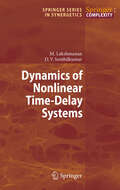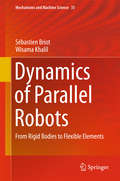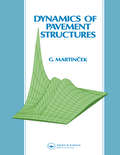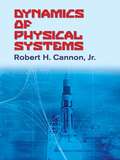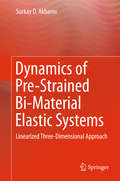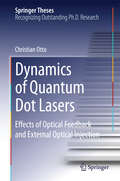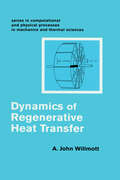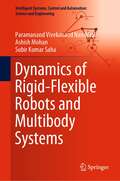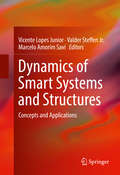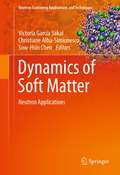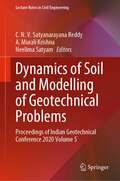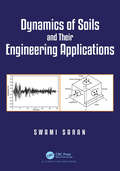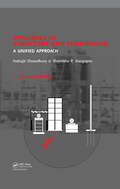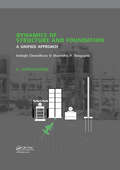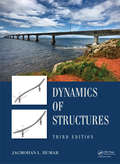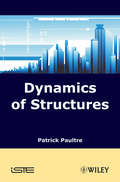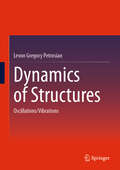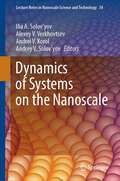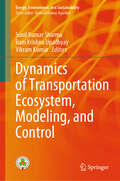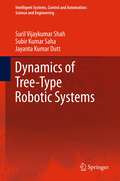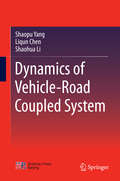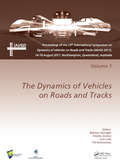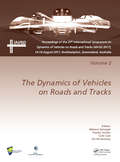- Table View
- List View
Dynamics of Nonlinear Time-Delay Systems
by Dharmapuri Vijayan Senthilkumar Muthusamy LakshmananSynchronization of chaotic systems, a patently nonlinear phenomenon, has emerged as a highly active interdisciplinary research topic at the interface of physics, biology, applied mathematics and engineering sciences. In this connection, time-delay systems described by delay differential equations have developed as particularly suitable tools for modeling specific dynamical systems. Indeed, time-delay is ubiquitous in many physical systems, for example due to finite switching speeds of amplifiers in electronic circuits, finite lengths of vehicles in traffic flows, finite signal propagation times in biological networks and circuits, and quite generally whenever memory effects are relevant. This monograph presents the basics of chaotic time-delay systems and their synchronization with an emphasis on the effects of time-delay feedback which give rise to new collective dynamics. Special attention is devoted to scalar chaotic/hyperchaotic time-delay systems, and some higher order models, occurring in different branches of science and technology as well as to the synchronization of their coupled versions. Last but not least, the presentation as a whole strives for a balance between the necessary mathematical description of the basics and the detailed presentation of real-world applications.
Dynamics of Parallel Robots
by Wisama Khalil Sébastien BriotThis book starts with a short recapitulation on basic concepts, common to any types of robots (serial, tree structure, parallel, etc. ), that are also necessary for computation of the dynamic models of parallel robots. Then, as dynamics requires the use of geometry and kinematics, the general equations of geometric and kinematic models of parallel robots are given. After, it is explained that parallel robot dynamic models can be obtained by decomposing the real robot into two virtual systems: a tree-structure robot (equivalent to the robot legs for which all joints would be actuated) plus a free body corresponding to the platform. Thus, the dynamics of rigid tree-structure robots is analyzed and algorithms to obtain their dynamic models in the most compact form are given. The dynamic model of the real rigid parallel robot is obtained by closing the loops through the use of the Lagrange multipliers. The problem of the dynamic model degeneracy near singularities is treated and optimal trajectory planning for crossing singularities is proposed. Lastly, the approach is extended to flexible parallel robots and the algorithms for computing their symbolic model in the most compact form are given. All theoretical developments are validated through experiments.
Dynamics of Pavement Structures
by Gustav MartincekThis book presents a rigorous treatment of the fundamental, mathematical behaviour of pavement structures under dynamic loading. The topic is of growing importance in economic design of aircraft runways and highway pavements. A range of modelling approaches are presented and compared with experimental data.
Dynamics of Physical Systems (Dover Civil and Mechanical Engineering)
by Dr Robert H. CannonA comprehensive text and reference for a first study of system dynamics and control, this volume emphasizes engineering concepts -- modeling, dynamics feedback, and stability, for example -- rather than mechanistic analysis procedures designed to yield routine answers to programmable problems. Its focus on physical modeling cultivates an appreciation for the breadth of dynamic systems without resorting to analogous electric-circuit formulation and analysis.After a careful treatment of the modeling of physical systems in several media and the derivation of the differential equations of motion, the text determines the physical behavior those equations connote: the free and forced motions of elementary systems and compound "systems of systems." Dynamic stability and natural behavior receive comprehensive linear treatment, and concluding chapters examine response to continuing and abrupt forcing inputs and present a fundamental treatment of analysis and synthesis of feedback control systems. This text's breadth is further realized through a series of examples and problems that develop physical insight in the best traditions of modern engineering and lead students into richer technical ground.As presented in this book, the concept of dynamics forms the basis for understanding not only physical devices, but also systems in such fields as management and transportation. Indeed, the fundamentals developed here constitute the common language of engineering, making this text applicable to a wide variety of undergraduate and graduate courses. 334 figures. 12 tables.
Dynamics of Pre-Strained Bi-Material Elastic Systems
by Surkay D. AkbarovThis book deals with dynamics of pre-stressed or pre-strained bi-material elastic systems consisting of stack of pre-stressed layers, stack of pre-stressed layers and pre-stressed half space (or half plane), stack of pre-stressed layers as well as absolute rigid foundation, pre-stressed compound solid and hollow cylinders and pre-stressed sandwich hollow cylinders. The problems considered in the book relate to the dynamics of a moving and oscillating moving load, forced vibration caused by linearly located or point located time-harmonic forces acting to the foregoing systems. Moreover, a considerable part of the book relate to the problems regarding the near surface, torsional and axisymmetric longitudinal waves propagation and dispersion in the noted above bi-material elastic systems. The book carries out the investigations within the framework of the piecewise homogeneous body model with the use of the Three-Dimensional Linearized Theory of Elastic Waves in Initially Stressed Bodies.
Dynamics of Quantum Dot Lasers
by Christian OttoThis thesis deals with the dynamics of state-of-the-art nanophotonic semiconductor structures, providing essential information on fundamental aspects of nonlinear dynamical systems on the one hand, and technological applications in modern telecommunication on the other. Three different complex laser structures are considered in detail: (i) a quantum-dot-based semiconductor laser under optical injection from a master laser, (ii) a quantum-dot laser with optical feedback from an external resonator, and (iii) a passively mode-locked quantum-well semiconductor laser with saturable absorber under optical feedback from an external resonator. Using a broad spectrum of methods, both numerical and analytical, this work achieves new fundamental insights into the interplay of microscopically based nonlinear laser dynamics and optical perturbations by delayed feedback and injection.
Dynamics of Regenerative Heat Transfer
by John A WillmottThe author, a respected authority on heat recovery, provides up-to-date and comprehensive coverage of the modelling of the process of heat transfer embodied in regenerative devices. He brings together material on storage and thermal generators and gives great emphasis to non-linear problems including the representation of temperature dependence of thermophysical properties involved.; In ten dynamic chapters, you will find coverage of: the storage of heat in packing; the Single Blow problem; basic concepts in counterflow thermal regenerators; counterflow regenerators; finite conductivity models; non-linear models of counterflow regenerators; transient response of counterflow regenerators; and parallel flow regenerators. Bringing together material developed over the past twenty years, the book will be of great interest to mechanical and chemical engineers as well as applied mathematicians concerned with models of heat transfer processes.
Dynamics of Rigid-Flexible Robots and Multibody Systems (Intelligent Systems, Control and Automation: Science and Engineering #100)
by Subir Kumar Saha Paramanand Vivekanand Nandihal Ashish MohanThis book discusses the dynamic analysis of rigid-flexible robots and multibody systems with serial as well as closed-loop architecture. The book presents a formulation of dynamic model of rigid-flexible robots based on the unique approach of de-coupling of natural orthogonal complements of velocity constraints. Based on this formulation, a computationally efficient and numerically stable forward dynamics algorithms for serial-chain and closed-loop robotic systems with rigid or flexible or rigid-flexible links is presented. The proposed algorithm is shown to be a numerically efficient for forward dynamics based on the investigation methodologies built on eigen value analytics. Precision and functionality of the simulation algorithms is presented/illustrated with application on different serial and closed-loop systems (both planar and spatial types). Some of the major robotic arms used to illustrate the proposed dynamic formulation and simulation algorithms are PUMA robot, Stanford robot arm, and Canadarm. It is envisaged that the book will be useful for researchers working on the development of rigid-flexible robots for use in defense, space, atomic energy, ocean exploration, and the manufacturing of biomedical equipment.
Dynamics of Smart Systems and Structures
by Vicente Lopes Junior Valder Steffen Jr. Marcelo Amorim SaviWritten by a team of experts that has been working togetherfor several years in the context of a research network involving internationalinstitutions, this book brings several applications related to smart materialsystems such as vibration and noise control, structural health monitoring,energy harvesting and shape memory alloys. Furthermore, this book also providesbasic knowledge on the fundamentals of smart material systems and structures. Consequently, the present title serves as an important resource for advancedundergraduate and graduate students. In addition, it serves as a guide forengineers and scientists working with smart structures and materials both withan application and basic research perspective. Smart material systems and structures represent a newparadigm which is increasing the capabilities of engineering systems. Adaptability and versatility are some important aspects related to suchsystems. In brief, research on smart materials is characterized by synergisticallycombining different physical features, such as mechanical, electrical,chemical, and magnetic. As a result, smart material technologies have a hugepotential to enhance the performance of engineering structures openingunlimited opportunities to innovation and economic benefits.
Dynamics of Soft Matter: Neutron Applications (Neutron Scattering Applications and Techniques)
by Christiane Alba-Simionesco Sow Hsin Chen Victoria Garcia SakaiDynamics of Soft Matter: Neutron Applications provides an overview of neutron scattering techniques that measure temporal and spatial correlations simultaneously, at the microscopic and/or mesoscopic scale. These techniques offer answers to new questions arising at the interface of physics, chemistry, and biology. Knowledge of the dynamics at these levels is crucial to understanding the soft matter field, which includes colloids, polymers, membranes, biological macromolecules, foams, emulsions towards biological & biomimetic systems, and phenomena involving wetting, friction, adhesion, or microfluidics. Emphasizing the complementarities of scattering techniques with other spectroscopic ones, this volume also highlights the potential gain in combining techniques such as rheology, NMR, light scattering, dielectric spectroscopy, as well as synchrotron radiation experiments. Key areas covered include polymer science, biological materials, complex fluids and surface science.
Dynamics of Soil and Modelling of Geotechnical Problems: Proceedings of Indian Geotechnical Conference 2020 Volume 5 (Lecture Notes in Civil Engineering #186)
by A. Murali Krishna C. N. V. Satyanarayana Reddy Neelima SatyamThis book provides information on the latest technological developments taking place in Geotechnical engineering, pertaining to Soil Dynamics and Modelling of Geotechnical Problems. The book is useful for the academicians and working professionals with coverage of both theoretical and practical aspects of Dynamics of Soil and Modelling studies on Geotechnical problems based on research findings and site specific inputs. The book serves as a useful reference resource for graduate and postgraduate students of civil engineering and contents of the book are helpful to the postgraduate students and research scholars in carrying out the research.
Dynamics of Soils and Their Engineering Applications
by Swami SaranThe book offers systematic dynamic analysis of soils and their engineering applications, including machine foundations, and aims to develop a clear understanding of the subject. It comprises sixteen chapters. Chapter 1 introduces the reader to the various problems in soil dynamics. In Chapter 2, concepts of theory of vibrations are discussed along with their applications in designing Vibration Absorbers and Pickups. Wave propagation in elastic medium including wave refraction in layered medium is covered in Chapter 3. Chapter 4 deals with the procedure of determining dynamic properties of soils using various laboratory and field tests. Dynamic earth pressures in retaining walls and dynamic bearing capacity of footings are dealt with in Chapters 5 and 6 respectively. Chapters 7and 8 respectively deal with dynamic behavior of pile foundations and slopes. Causes of liquefaction of soils and prediction of liquefaction potential have been discussed in Chapter 9. In Chapter 10, the procedure of estimating the unbalanced forces in various types of machines are covered. Chapters 11, 12 and 13 deal with the analysis and design of foundations of reciprocating machine, hammer, and turbo-generators respectively. In Chapter 14, problems of vibration isolation and screening are dealt with. Chapter 15 discusses the analysis and design of reinforced earth wall located in seismic areas. A new concept of a conventional rigid retaining wall having reinforced backfill is presented in Chapter 16, giving complete analysis and design procedure considering seismic forces.
Dynamics of Structure and Foundation - A Unified Approach: 1. Fundamentals
by Indrajit Chowdhury Shambhu P. DasguptaDesigned to provide engineers with quick access to current and practical information on the dynamics of structure and foundation, this unique work, consisting of two separately available volumes, serves as a complete reference, especially for those involved with earthquake or dynamic analysis, or the design of machine foundations in the oil, gas, a
Dynamics of Structure and Foundation - A Unified Approach: 2. Applications
by Indrajit Chowdhury Shambhu P. DasguptaDesigned to provide engineers with quick access to current and practical information on the dynamics of structure and foundation, this 2-volume reference work is intended for engineers involved with earthquake or dynamic analysis, or the design of machine foundations in the oil, gas, and energy sector. Whereas Volume 1 (ISBN 9780415471459
Dynamics of Structures
by J. HumarThis major textbook provides comprehensive coverage of the analytical tools required to determine the dynamic response of structures. The topics covered include: formulation of the equations of motion for single- as well as multi-degree-of-freedom discrete systems using the principles of both vector mechanics and analytical mechanics; free vibratio
Dynamics of Structures
by Patrick PaultreThis book covers structural dynamics from a theoretical and algorithmic approach. It covers systems with both single and multiple degrees-of-freedom. Numerous case studies are given to provide the reader with a deeper insight into the practicalities of the area, and the solutions to these case studies are given in terms of real-time and frequency in both geometric and modal spaces. Emphasis is also given to the subject of seismic loading. The text is based on many lectures on the subject of structural dynamics given at numerous institutions and thus will be an accessible and practical aid to students of the subject. Key features: Examines the effects of loads, impacts, and seismic forces on the materials used in the construction of buildings, bridges, tunnels, and more Structural dynamics is a critical aspect of the design of all engineered/designed structures and objects - allowing for accurate prediction of their ability to withstand service loading, and for knowledge of failure-causeing or critical loads
Dynamics of Structures: Oscillations/Vibrations
by Levon Gregory PetrosianThis book presents dynamic calculation in the context of structural mechanics and civil engineering. It explains the process of testing the strength of structures and determining the dynamic displacements, velocities, and accelerations, whose values; as measured by the influence of vibrations on people, and certain types of precision equipment, such as measuring instruments, high-precision machines, and equipment for microelectronics production, should not exceed the permissible limits. The first part of the book (15 chapters) is ideal as a textbook for advanced undergraduate, graduate, or post-graduate students taking their first course in structural dynamics. This text can be used for two semesters. In addition, the book will serve as a primary reference for practicing engineers and research workers, as well as a self-study guide for students, researchers, and professional engineers. The second part of the book (chapter 16 onwards) is intended mainly for professionals and specialists in the field of dynamics of structures and related areas.
Dynamics of Systems on the Nanoscale (Lecture Notes in Nanoscale Science and Technology #34)
by Andrey V. Solov’yov Ilia A. Solov’yov Alexey V. Verkhovtsev Andrei V. KorolThis book presents the structure formation and dynamics of animate and inanimate matter on the nanometre scale. This is a new interdisciplinary field known as Meso-Bio-Nano (MBN) science that lies at the intersection of physics, chemistry, biology and material science. Special attention in the book is devoted to investigations of the structure, properties and dynamics of complex MBN systems by means of photonic, electronic, heavy particle and atomic collisions. This includes problems of fusion and fission, fragmentation, surfaces and interfaces, reactivity, nanoscale phase and morphological transitions, irradiation-driven transformations of complex molecular systems, collective electron excitations, radiation damage and biodamage, channeling phenomena and many more. Emphasis in the book is placed on the theoretical and computational physics research advances in these areas and related state-of-the-art experiments. Particular attention in the book is devoted to the utilization of advanced computational techniques and high-performance computing in studies of the dynamics of systems.
Dynamics of Tethered Space Systems (Advances in Engineering Series)
by Hans Troger A.P. Alpatov V.V. Beletsky V.I. Dranovskii V.S. Khoroshilov A.V. Pirozhenko A.E. ZakrzhevskiiDuring many of the earliest American and Russian space missions, experiments were performed using cables to connect people and objects to spacecraft in orbit. These attempts generated considerable information about the formation of tethered systems and basic problems with tether orientation and gravity-gradient stabilization. During the 1970s, inte
Dynamics of Transportation Ecosystem, Modeling, and Control (Energy, Environment, and Sustainability)
by Vikram Kumar Ram Krishna Upadhyay Sunil Kumar SharmaTransportation is the lifeblood of modern society, connecting people, goods, and information across the world. However, as our cities grow and the demand for transportation increases, it becomes imperative to understand and manage the intricate dynamics of the transportation ecosystem. This book provides an in-depth exploration of the complex dynamics of transportation systems, with a focus on modeling and control strategies that can enhance efficiency, sustainability, and resilience. It is an indispensable resource for transportation engineers, researchers, students, and professionals seeking a comprehensive understanding of the complex dynamics at play in transportation systems. By delving into advanced modeling techniques, control strategies, and sustainability considerations, this book equips readers with the knowledge needed to navigate and optimize the evolving transportation landscape. This book offers a comprehensive examination of the interconnected elements within the transportation ecosystem, including vehicles, infrastructure, traffic flow, and emerging technologies. It explores advanced modeling and simulation techniques for understanding and predicting transportation system behavior, discussing control strategies that can be applied to optimize transportation systems, enhancing safety, and mitigating congestion, addressing the challenges of sustainability and resilience in transportation, including the integration of eco-friendly technologies and disaster response.
Dynamics of Tree-Type Robotic Systems
by Jayanta Kumar Dutt Subir Kumar Saha Suril Vijaykumar ShahThis book addresses dynamic modelling methodology and analyses of tree-type robotic systems. Such analyses are required to visualize the motion of a system without really building it. The book contains novel treatment of the tree-type systems using concept of kinematic modules and the corresponding Decoupled Natural Orthogonal Complements (DeNOC), unified representation of the multiple-degrees-of freedom-joints, efficient recursive dynamics algorithms, and detailed dynamic analyses of several legged robots. The book will help graduate students, researchers and practicing engineers in applying their knowledge of dynamics for analysis of complex robotic systems. The knowledge contained in the book will help one in virtual testing of robot operation, trajectory planning and control.
Dynamics of Underactuated Multibody Systems
by Robert SeifriedUnderactuated multibody systems are intriguing mechatronic systems, as they posses fewer control inputs than degrees of freedom. Some examples are modern light-weight flexible robots and articulated manipulators with passive joints. This book investigates such underactuated multibody systems from an integrated perspective. This includes all major steps from the modeling of rigid and flexible multibody systems, through nonlinear control theory, to optimal system design. The underlying theories and techniques from these different fields are presented using a self-contained and unified approach and notation system. Subsequently, the book focuses on applications to large multibody systems with multiple degrees of freedom, which require a combination of symbolical and numerical procedures. Finally, an integrated, optimization-based design procedure is proposed, whereby both structural and control design are considered concurrently. Each chapter is supplemented by illustrated examples.
Dynamics of Vehicle-Road Coupled System
by Liqun Chen Shaopu Yang Shaohua LiVehicle dynamics and road dynamics are usually considered to be two largely independent subjects. In vehicle dynamics, road surface roughness is generally regarded as random excitation of the vehicle, while in road dynamics, the vehicle is generally regarded as a moving load acting on the pavement. This book suggests a new research concept to integrate the vehicle and the road system with the help of a tire model, and establishes a cross-subject research framework dubbed vehicle-pavement coupled system dynamics. In this context, the dynamics of the vehicle, road and the vehicle-road coupled system are investigated by means of theoretical analysis, numerical simulations and field tests. This book will be a valuable resource for university professors, graduate students and engineers majoring in automotive design, mechanical engineering, highway engineering and other related areas. Shaopu Yang is a professor and deputy president of Shijiazhuang Tiedao University, China; Liqun Chen is a professor at Shanghai University, Shanghai, China; Shaohua Li is a professor at Shijiazhuang Tiedao University, China.
Dynamics of Vehicles on Roads and Tracks Vol 1: Proceedings of the 25th International Symposium on Dynamics of Vehicles on Roads and Tracks (IAVSD 2017), 14-18 August 2017, Rockhampton, Queensland, Australia
by Maksym Spiryagin Timothy Gordon Colin Cole Tim McSweeneyThe International Symposium on Dynamics of Vehicles on Roads and Tracks is the leading international gathering of scientists and engineers from academia and industry in the field of ground vehicle dynamics to present and exchange their latest innovations and breakthroughs. Established in Vienna in 1977, the International Association of Vehicle System Dynamics (IAVSD) has since held its biennial symposia throughout Europe and in the USA, Canada, Japan, South Africa and China. The main objectives of IAVSD are to promote the development of the science of vehicle dynamics and to encourage engineering applications of this field of science, to inform scientists and engineers on the current state-of-the-art in the field of vehicle dynamics and to broaden contacts among persons and organisations of the various countries engaged in scientific research and development in the field of vehicle dynamics and related areas. IAVSD 2017, the 25th Symposium of the International Association of Vehicle System Dynamics was hosted by the Centre for Railway Engineering at Central Queensland University, Rockhampton, Australia in August 2017. The symposium focused on the following topics related to road and rail vehicles and trains: dynamics and stability; vibration and comfort; suspension; steering; traction and braking; active safety systems; advanced driver assistance systems; autonomous road and rail vehicles; adhesion and friction; wheel-rail contact; tyre-road interaction; aerodynamics and crosswind; pantograph-catenary dynamics; modelling and simulation; driver-vehicle interaction; field and laboratory testing; vehicle control and mechatronics; performance and optimization; instrumentation and condition monitoring; and environmental considerations. Providing a comprehensive review of the latest innovative developments and practical applications in road and rail vehicle dynamics, the 213 papers now published in these proceedings will contribute greatly to a better understanding of related problems and will serve as a reference for researchers and engineers active in this specialised field. Volume 1 contains 78 papers under the subject heading Road.
Dynamics of Vehicles on Roads and Tracks Vol 2: Proceedings of the 25th International Symposium on Dynamics of Vehicles on Roads and Tracks (IAVSD 2017), 14-18 August 2017, Rockhampton, Queensland, Australia
by Maksym Spiryagin Timothy Gordon Colin Cole Tim McSweeneyThe International Symposium on Dynamics of Vehicles on Roads and Tracks is the leading international gathering of scientists and engineers from academia and industry in the field of ground vehicle dynamics to present and exchange their latest innovations and breakthroughs. Established in Vienna in 1977, the International Association of Vehicle System Dynamics (IAVSD) has since held its biennial symposia throughout Europe and in the USA, Canada, Japan, South Africa and China. The main objectives of IAVSD are to promote the development of the science of vehicle dynamics and to encourage engineering applications of this field of science, to inform scientists and engineers on the current state-of-the-art in the field of vehicle dynamics and to broaden contacts among persons and organisations of the various countries engaged in scientific research and development in the field of vehicle dynamics and related areas. IAVSD 2017, the 25th Symposium of the International Association of Vehicle System Dynamics was hosted by the Centre for Railway Engineering at Central Queensland University, Rockhampton, Australia in August 2017. The symposium focused on the following topics related to road and rail vehicles and trains: dynamics and stability; vibration and comfort; suspension; steering; traction and braking; active safety systems; advanced driver assistance systems; autonomous road and rail vehicles; adhesion and friction; wheel-rail contact; tyre-road interaction; aerodynamics and crosswind; pantograph-catenary dynamics; modelling and simulation; driver-vehicle interaction; field and laboratory testing; vehicle control and mechatronics; performance and optimization; instrumentation and condition monitoring; and environmental considerations. Providing a comprehensive review of the latest innovative developments and practical applications in road and rail vehicle dynamics, the 213 papers now published in these proceedings will contribute greatly to a better understanding of related problems and will serve as a reference for researchers and engineers active in this specialised field. Volume 2 contains 135 papers under the subject heading Rail.
